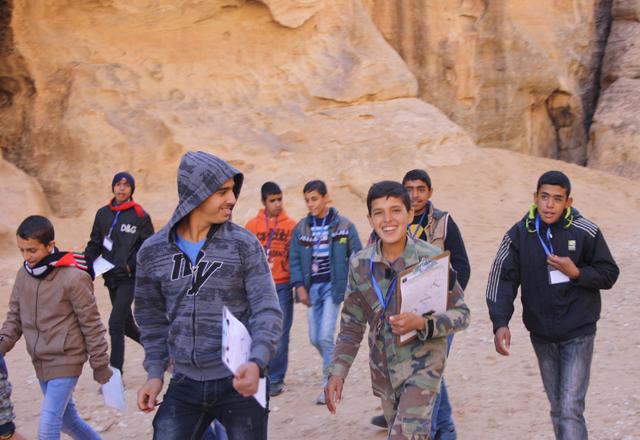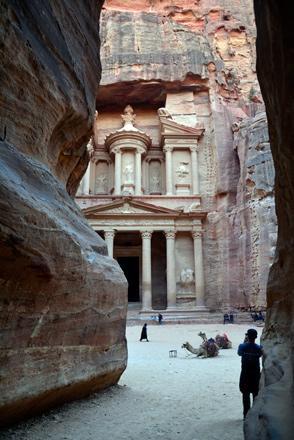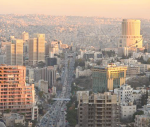You are here
Panel focuses on mitigating impacts of disasters on heritage sites
By Ana V. Ibáñez Prieto - Nov 09,2017 - Last updated at Nov 09,2017
DEAD SEA — Director General of the Department of Antiquities Monther Jamhawi said on Wednesday that “the development sector presents an important issue regarding the conservation of our heritage, at the same time they help the public, they are increasing our heritage’s vulnerability to disaster risk.”
The remarks came during the thematic session “Disaster Risk Reduction at Heritage Sites [UNESCO]”, which came as part of the World Science Forum 2017 inaugurated on Monday under the title “Science for Peace”.
The five-day event, which is the largest scientific event in the region, is taking place at the King Hussein Bin Talal Convention Centre at the Dead Sea, attracting world-renowned academics, policymakers and experts in the scientific field.
“The sole title of this session evokes the many challenges that our more than 100,000 heritage sites are facing, and that is why our focus today is set on finding the ways to mitigate the threats imposed by disaster risk,” said Jamhawi.
President of ICOMOS-ICORP in India Rohit Jigyasu was the first speaker of the session, delivering a lecture on the international framework for disaster risk management.
Jigyasu started out his address by citing examples of recent disasters such as the earthquakes in Mexico, Chauk and Nepal, noting the need to “take into account that the natural disasters never come alone, as they are usually followed by the damage of collateral fires and even nuclear emergencies”.
Furthermore, the expert pointed out a series of factors that increase the vulnerability of heritage sites such as climate change, increased urbanisation and additions and alterations to heritage sites.
“This is why we need an integrated framework focused on prevention and mitigation,” he continued, adding that “we should look forward to enhance preparedness, the synergies between risk reduction at natural and cultural sites, and the cooperation between the heritage sector and civil defence.”
Jigyatsu’s lecture was followed by the speech of Mauro dolce, director general of the Protezione Civile (civil protection) in Italy, who presented Italy’s civil defence model as an example of the ways in which the government can contribute to the protection of heritage in disaster scenarios.
In this regard, Dolce pointed out how “Italy’s Protezione Civile does not work as a single administration, but a complex system where several ministries can take action, along with citizens and members of private and public institutions who can act as volunteers.”
Furthermore, Dolce outlined the PROMEDHE project lead by Italy’s Protezione Civile, where civil protection authorities from Israel, Cyprus, Palestine and Jordan joined efforts to “strengthen disaster preparedness capacities to respond to natural and man-made disasters”, and to “implement common tools and methods to safeguard cultural heritage”.
The thematic session was concluded by Giorgia Cesaro, associate project officer at UNESCO Amman Office, who offered an overview of the “Siq Stability” project for hazard risk mitigation in Petra.
“The project was initiated by UNESCO in order to address the challenges posed by the falling rocks in the Siq, a 1.2km long gorge serving as the only tourist entrance to the site,” explained Cesaro, noting that “the objective is to provide authorities with the necessary resources to solve the slope instability.”
“The project, still ongoing, will result on an enhanced management of the site through the development of natural hazard risk preparedness strategies,” said Cesaro, adding that “tourist safety will be increased thanks to the implementation of risk mitigation measures.”
“Furthermore, the methodology used for this project can be replicated in other areas of the site exposed to similar hazards, and contribute to the development of a disaster risk plan for the site,” concluded Cesaro.
Related Articles
By Emily Bruser and Giorgia CesaroUNESCOAMMAN — With funding from the Italian government, the UNESCO Amman office is implementing a project
AMMAN — UNESCO on Tuesday launched the second phase of the project “SIQ STABILITY — Mitigation of Immediate Hazards in the Siq of Petra” at
AMMAN — UNESCO project “Employment Opportunities for Cultural Heritage Safeguarding in Jordan” aims to invest in cultural heritage preservat



















